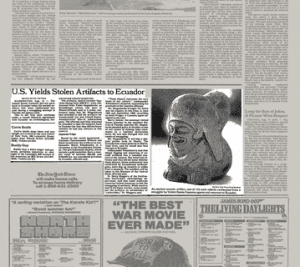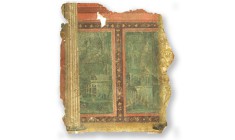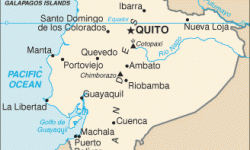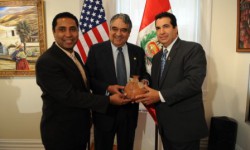Ecuadorian Artefacts Seized in Miami in 1986
Author: Donna Yates
Last Modified: 30 Nov 2023

The trafficker, who planned on buying weapons with the proceeds from sale of the artefacts, was convicted of US customs violations after he was denounced by a confidential informant
Figurines of Ancient Manabí
The Jama-Coaque Culture was located in the northern part of Ecuador’s Manabí Provence in the region of the Jama Valley. The archaeological site of San Isidro, located in the middle of the valley and about 25 km from the coast, appears to have served as an important central place for the culture, perhaps as a “regional ceremonial and administrative centre” (Masucci 2008: 494). Archaeological research characterises the Jama-Coaque as being a “chiefly polity” that controlled portions of an important river valley and thus important trade routes (Masucci 2008: 495). Human occupation of this valley was disrupted by multiple major volcanic eruptions, causing breaks in cultural continuity, but archaeological research has shown that major Jama-Coaque sites were eventually reoccupied, speaking to their logistical or spiritual significance (Cummins 2019: 67–68).
Outside of Ecuador, Jama-Coaque is primarily known as the source of a “large number of looted figurines characterized by elaborate decoration representing complex apparel as well as ritual paraphernalia and possessions that mark social and political rank” (Masucci 2008: 495; see Cummins 1994). Some Jama-Coaque figurines are so detailed they required up to nine different molds to produce (Cummins 2019: 71). The detailed nature of the adornment of these modeled or molded figurines offer a window into elite Jama-Coaque life, preserving elements of dress which are not otherwise preserved in the archaeological record, such as textiles and body paint.
However, the fact that so many Jama-Coaque figurines are looted reduces scholars’ ability to contextualise these features and place them within space and time (Cummins 2019: 69), and has allowed the corpus of figurines to become corrupted by fakes. No Jama-Coaque figurine production site has been located by archaeologists (Masucci 2008), and while some smaller solid Jama-Coaque figurines have been archaeologically excavated, none of the larger mold-made figurines have ever been found in an controlled archaeological dig (Cummins 2019: 66). Whole classes of Jama Coaque figurines are only known from the art market.
The Bahía Culture was located primarily within the tropical forests of Manabí’s southern and central coast (Masucci 2008: 496). Many of the primary Bahía sites that were identified in the mid 20th century are now beneath the modern city of Manta. The Bahía Culture also produced figurines that are appealing to the art market, however in a different style to their Jama-Coaque neighbours. Bahía figurines were either modeled or molded, and portray elaborately dressed people who hold ritual and social objects (Masucci 2008: 496).
A Confidential Informant in Miami
On 25 September 1986, an Ecuadorian citizen named Fabio Mauricio Magnalardo entered the United States at Miami International Airport. At the time he was carrying ancient Bahía and Jama Coaque figurines which he did not declare to United States Customs (South Florida SunSentinel 1986). Magnalardo, who the contemporary press described as a self-employed businessman, had previously been a high school international exchange student in Miami (South Florida SunSentinel 1986).
On 28 September, a confidential informant contacted the United States Customs Service and indicated that Magnalardo had brought the figures into the United States illegally and was looking for a buyer (South Florida SunSentinel 1986). The United States Customs Service then set up a sting operation involving the confidential informant as well as a person that Magnalardo was led to believe would authenticate the artefacts. On 2 October the informant made an audio recording of Magnalardo stating that he wished to sell the artefacts for $90,000 USD. On 6 October Magnalardo was arrested while going to meet the person he thought would authenticate the pieces (South Florida SunSentinel 1986).
Magnalardo pleaded guilty to making a false statement to the United States Customs Service for not declaring the artefacts at Miami International Airport. He had initially been charged with another count of making a false statement as well as two counts of smuggling, but the U.S. Attorney’s Office dropped the charges in exchange for his guilty plea (South Florida SunSentinel 1986). He was sentenced to one year in prison (New York Times 1987). At a 1987 press conference concerning the case, United States Officials stated that Magnalardo had intended to use the proceeds from artefact sales to buy uzis and mac-10 submachine guns (New York Times 1987). These Magnalardo intended to take back to Ecuador for unknown purposes.
While initial reports indicated that Magnalardo smuggled 60 pieces (e.g. South Florida SunSentinel 1986), contemporary press covering the August 1987 return of the artefacts to Ecuador place the count at 153 (New York Times 1987). Reporting at that time indicates that Magnalardo actually engaged in two smuggling trips, one in June 1985 and another in September 1986 (New York Times 1987), and it is possible that the discrepancy relates to these previously-smuggled objects.
Violation of Ecuador’s Laws
In the United States Magnalardo was ultimately found guilty of customs violations that were technically unrelated to the illicit nature of the artefacts he was carrying. However, under Ecuadorian law even at that time, Magnalardo was not able to legally own the pieces and was not able to legally remove them from Ecuador. Ackerman’s (1984) summary of Ecuadorian cultural property law from the 1980s affirms that in Ecuador at the time:
- All archaeological excavations, even on private land, required permission to dig from the Department of Culture. This means that digging for artefacts without formal permission, as was likely the case with these pieces, was a violation of the law. Any object resulting from such digging “would automatically be considered stolen cultural property” under Ecuador’s law (Ackerman 1984: 423–424).
- Since 1945 privately owned ancient objects had to be registered with the State, making them private property under State protection.
- Unregistered ancient objects could not be lawfully exported from Ecuador or sold under any circumstance. Registered ancient objects could only be exported from Ecuador or sold with official permission.
Since the objects in question had neither been officially registered as privately owned with Ecuadorian authorities, nor had Ecuadorian authorities granted a permit for their export or sale, it seems clear Ecuador’s laws were violated in this case. In the reporting related to the conviction, United States authorities indicated that after Magnalardo served his time he would be deported to Ecuador where he would likely face charges (South Florida Sun Sentinel 1986; New York Time 1987). It is unclear if this occurred.
[Image: Screenshot (Yates 9 Nov 2023) of NYT article showing one of the pieces.]
Works Cited
Ackerman, Lisa (1984) Italian Court Returns Artifacts to Ecuador, Journal of Field Archaeology 11(4): 422–424). https://www.jstor.org/stable/529321
Cummins, Thomas (2019) The Jama-Coaque mold-made figurines from coastal Ecuador: The case for continuity. Res: Anthropology and Aesthetics. 71/72.
Cummins, Thomas (1994) La tradición de figurinas de la costa ecuatoriana: Estilo tecnológico y el uso de moldes. In: Tecnología y Organización de la Cerámica Prehispánica en los Andes, edited by Izumi Shimada. Lima: Fondo Editorial, Pontificia Universidad Católica del Perú. pp. 157–172.
Masucci, Maria A. (2008) Early Regional Polities of Coastal Ecuador. In: The Handbook of South American Archaeology, edited Helane Silverman and William H. Isbel. New York: Springer. https://doi.org/10.1007/978-0-387-74907-5_25
New York Times (1987) U.S. Yields Stolen Artifacts to Ecuador. The New New Yorks Times. 15 August. https://web.archive.org/web/20150524211536/http://www.nytimes.com/1987/08/15/arts/us-yields-stolen-artifacts-to-ecuador.html. Accessed 30 August 2023.
South Florida Sun Sentinel (1986) Man Pleads Guilty in Artifacts Case. South Florida SunSentinel. 18 December. https://web.archive.org/web/20230830092425/https://www.sun-sentinel.com/1986/12/18/man-pleads-guilty-in-artifacts-case/. Accessed on 30 August 2023.



